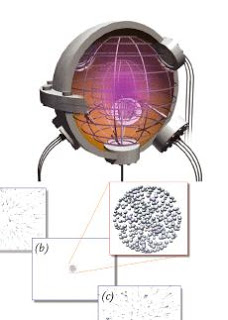Ad Support : Nano Technology Netbook Technology News Computer Software
Inertial-electrostatic-confinement (IEC) systems provide an economical and technologically straightforward means to produce fusion reactions in a table-top device. IEC devices confine a plasma in a potential well created by electrostatic fields or a combination of electrostatic and magnetic fields. The fields can be produced either by grids or by virtual cathodes, typically in spherical or cylindrical geometry. The fields accelerate ions towards the center of the device, where fusion reactions can occur
Though useful for practical neutron sources, the IEC fusion devices before the work of Robert Bussard suffered low fusion yields, ~ 0.01% of input power. Also, Periodically Oscillating Plasma Sphere (POPS) processes can boost the fusion yield.
Periodically Oscillating Plasma Sphere
The ion beams in the IEC device rapidly lose the energy by Coulomb collisions before producing fusion reactions, leading to a net loss in energy.
A new electrostatic plasma equilibrium that should mitigate this problem has been proposed by LANL theorists and recently confirmed experimentally. This concept requires uniform electron injection into the central region of a spherical device to produce harmonic oscillator potential. An ion cloud (referred to as the Periodically Oscillating Plasma Sphere, or POPS) in such an environment will undergo harmonic oscillation with an oscillation frequency independent of amplitude. Tuning the external radio-frequency (rf) electric fields to this naturally occurring mode allows the ion motions to be phase-locked. This simultaneously produces very high densities and temperatures during the collapse phase of the oscillation when all the ions converge into the center. Solutions to POPS oscillation have the remarkable property that they maintain equilibrium distribution of the ions at all times. This would eliminate any power loss due to Coulomb collisions and would greatly increase the neutron yield up to more than 100%, resulting in a net energy gain for fusion-power generation.
In a practical embodiment, the POPS system would use a massively modular system to achieve high-mass-power density as shown in the conceptual drawing in Figure 2. Such a device would contain thousands of tiny spherical IEC reactors within a single reactor vessel to produce a large amount of fusion power (i.e., ~ 100–1000 MW). A modular IEC device would have very high-mass-power density, comparable to a light-water reactor, while maintaining conventional wall loads (~ 1 MW/m2) and being economically competitive with other sources of power.
If you liked this article, please give it a quick review on Reddit, or StumbleUpon. Thanks
Supporting Advertising
Business Success
How to Make Money
Executive Jobs
Paid Surveys
Thank You

Brian Wang is a Futurist Thought Leader and a popular Science blogger with 1 million readers per month. His blog Nextbigfuture.com is ranked #1 Science News Blog. It covers many disruptive technology and trends including Space, Robotics, Artificial Intelligence, Medicine, Anti-aging Biotechnology, and Nanotechnology.
Known for identifying cutting edge technologies, he is currently a Co-Founder of a startup and fundraiser for high potential early-stage companies. He is the Head of Research for Allocations for deep technology investments and an Angel Investor at Space Angels.
A frequent speaker at corporations, he has been a TEDx speaker, a Singularity University speaker and guest at numerous interviews for radio and podcasts. He is open to public speaking and advising engagements.



